3.09.2021
IMAP Mission Advances to Next Development Stage
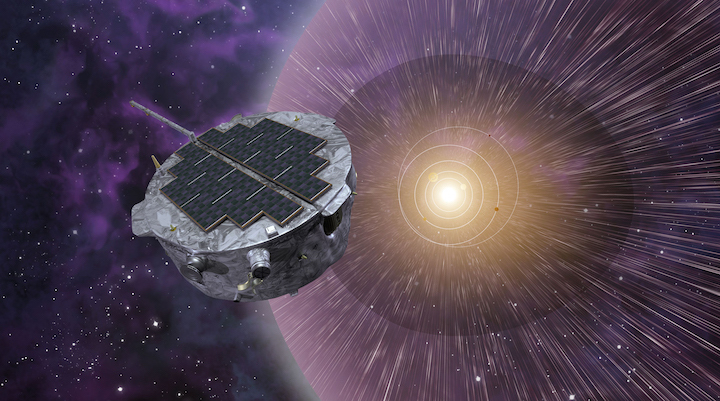
Artist’s impression of the Interstellar Mapping and Acceleration Probe (IMAP). The mission will help us better understand the flow of particles from the Sun called the solar wind — and how those particles interact with space within the solar system and beyond. Credit: NASA/Johns Hopkins APL/Princeton University/Steve Gribben
NASA has given Princeton University, the Johns Hopkins Applied Physics Laboratory (APL) and their many partner institutions the go-ahead to begin implementing the Interstellar Mapping and Acceleration Probe (IMAP) — a mission to sample, analyze and map particles streaming to Earth from the edges of interstellar space.
Set to launch in February 2025, IMAP will investigate two critical issues in space physics: the acceleration of energetic particles from the Sun and the interaction of these particles — known as the solar wind — with the interstellar medium. The solar-powered spacecraft will be positioned about one million miles (1.5 million kilometers) away from Earth and toward the Sun at what is called the first Lagrange point, where it can monitor the interactions between the solar wind and the interstellar medium in the outer solar system.
In May, the IMAP team underwent a preliminary design review, covering topics such as spacecraft design, mission requirements, science plans, schedule and costs. Held at APL, which manages the mission and will build and operate the IMAP spacecraft, the review included a panel of external experts tasked with evaluating the information and assessing mission progress for NASA. Following a subsequent meeting, the team received confirmation from NASA on July 12 to proceed to the next stage of development, which includes the detailed, final spacecraft and mission design.
“This review was a significant step forward,” said Princeton University astrophysics professor David McComas, who, as IMAP principal investigator, leads the mission and its international team of 24 partner institutions. “The team has worked very hard to show that we are on track to meet the cost, schedule and technical requirements of a challenging mission, and the reviewers recognized that.”
Carrying 10 science instruments provided by international and domestic research organizations and universities, IMAP will help researchers better understand the boundary of the heliosphere, the magnetic “bubble” surrounding and protecting our solar system. It’s here where the constant flow of the solar wind collides with material from the rest of the galaxy. This collision limits the amount of harmful cosmic radiation entering the heliosphere, and by collecting and analyzing the particles that make it through, IMAP will reveal just how the heliosphere filters cosmic rays.
The mission also aims to learn more about the generation of cosmic rays in the heliosphere; these particles pose risks to astronauts and technological systems, but they may also play a role in the formation and presence of life in the universe.
“With science and engineering expertise from around the world, the IMAP team has a deep experience in missions designed to examine, in depth, the Sun’s effects on our solar system and the space beyond,” said Joe Westlake, the IMAP project scientist from APL. “We’re excited to fine-tune the designs on a spacecraft and mission that will deliver unprecedented science.”
IMAP is the fifth mission in NASA’s Solar Terrestrial Probes (STP) Program portfolio. The Heliophysics Program Office at NASA’s Goddard Space Flight Center in Greenbelt, Maryland, manages the STP Program for the agency’s Heliophysics Division of NASA’s Science Mission Directorate.
Quelle: THE JOHNS HOPKINS UNIVERSITY
----
Update: 24.12.2024
.
NASA delays launch of heliophysics missions
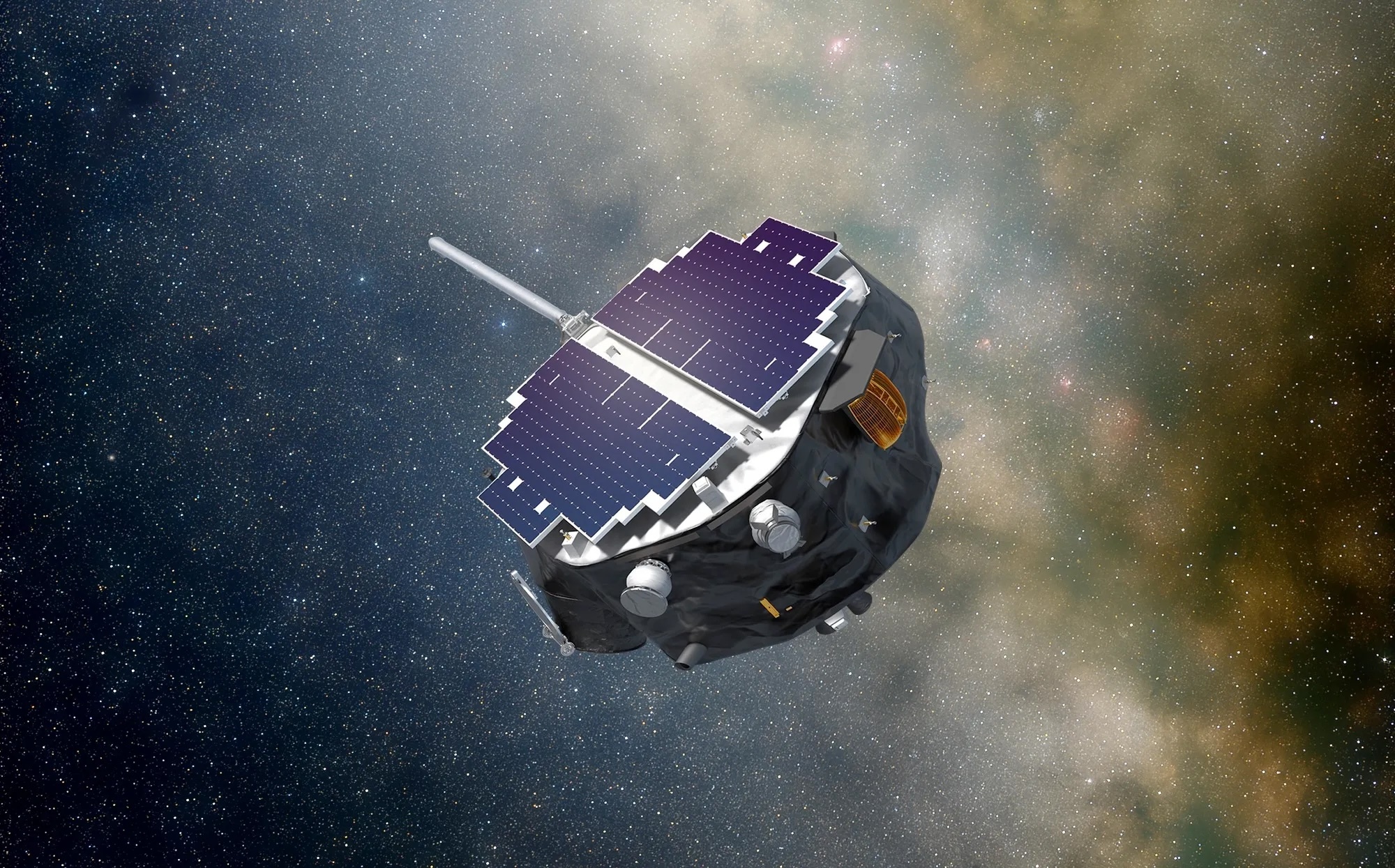
NASA's IMAP mission is now scheduled to launch no earlier than September 2025. Credit: NASA/Princeton/Patrick McPike
WASHINGTON — NASA is delaying the launch of three missions to study the sun by several months because of issues with the primary payload.
In a statement issued after the close of business Dec. 20, NASA announced the launch of its Interstellar Mapping and Acceleration Probe (IMAP) spacecraft on a Falcon 9, previously scheduled for the spring of 2025, had been pushed back to no earlier than September. The agency said only that the delay gives “additional time for IMAP flight systems preparations prior to launch.”
A Dec. 18 preview by NASA’s Kennedy Space Center for 2025 mentioned that IMAP would launch in “late 2025” but was not more specific.
IMAP will operate from the Earth-sun L-1 Lagrange point, 1.5 million kilometers from Earth in the direction of the sun. It will study the heliosphere, the magnetic bubble created by the sun that shields the solar system from interstellar particles. It will also examine the solar wind.
“IMAP is a mission that has two halves,” said Joe Westlake, director of NASA’s heliophysics division, during a town hall session at the annual meeting of the American Geophysical Union Dec. 9. The mission, he described, will explore the heliosphere and local solar neighborhood but also has a role “safeguarding humanity” by monitoring solar weather. In that presentation he offered no hint of any delay in the mission.
IMAP was once scheduled to launch in 2024 but has slipped several times. In November 2023, NASA delayed the launch from February 2025 to April or May 2025 after completing a review called Key Decision Point D, stating that then delay would “ensure that the project team has adequate resources to address risks and technical complexities during system integration and testing.”
The delay in IMAP affects two other missions flying as rideshare payloads on the launch. One, the Carruthers Geocorona Observatory (formerly known as Global Lyman-alpha Imager of the Dynamic Exosphere or GLIDE), will study the outermost region of the Earth’s atmosphere, the exosphere, from the Earth-sun L-1 point. Space Weather Follow-On (SWFO) L-1 is a National Oceanic and Atmospheric Administration mission to monitor solar weather from the Earth-sun L-1 point for operational purposes, including space weather forecasting.
“With this mission, we’re leaning into the ability to take rideshares,” Westlake said at the town hall meeting, “to look at the ability of each launch to squeeze as much science as we can on every chance to get off of this Earth.”
The launch, awarded by NASA to SpaceX in 2020, originally carried two other rideshare payloads. One, a solar sail mission called Solar Cruiser, failed to advance to phase C of its development because of technical issues and was terminated in 2023. The other, the Lunar Trailblazer lunar orbiter, was moved off the mission in 2022, with NASA instead purchasing a rideshare launch slot on the IM-2 lunar lander mission by Intuitive Machines.
NASA said at the time it moved Lunar Trailblazer off the IMAP launch to avoid delays, hoping at the time that IM-2 would launch in 2023. That mission is instead scheduled to launch no earlier than February 2025.
Quelle: SN
----
Update: 13.05.2025
.
NASA’s Interstellar Mapping Mission Arrives in Florida
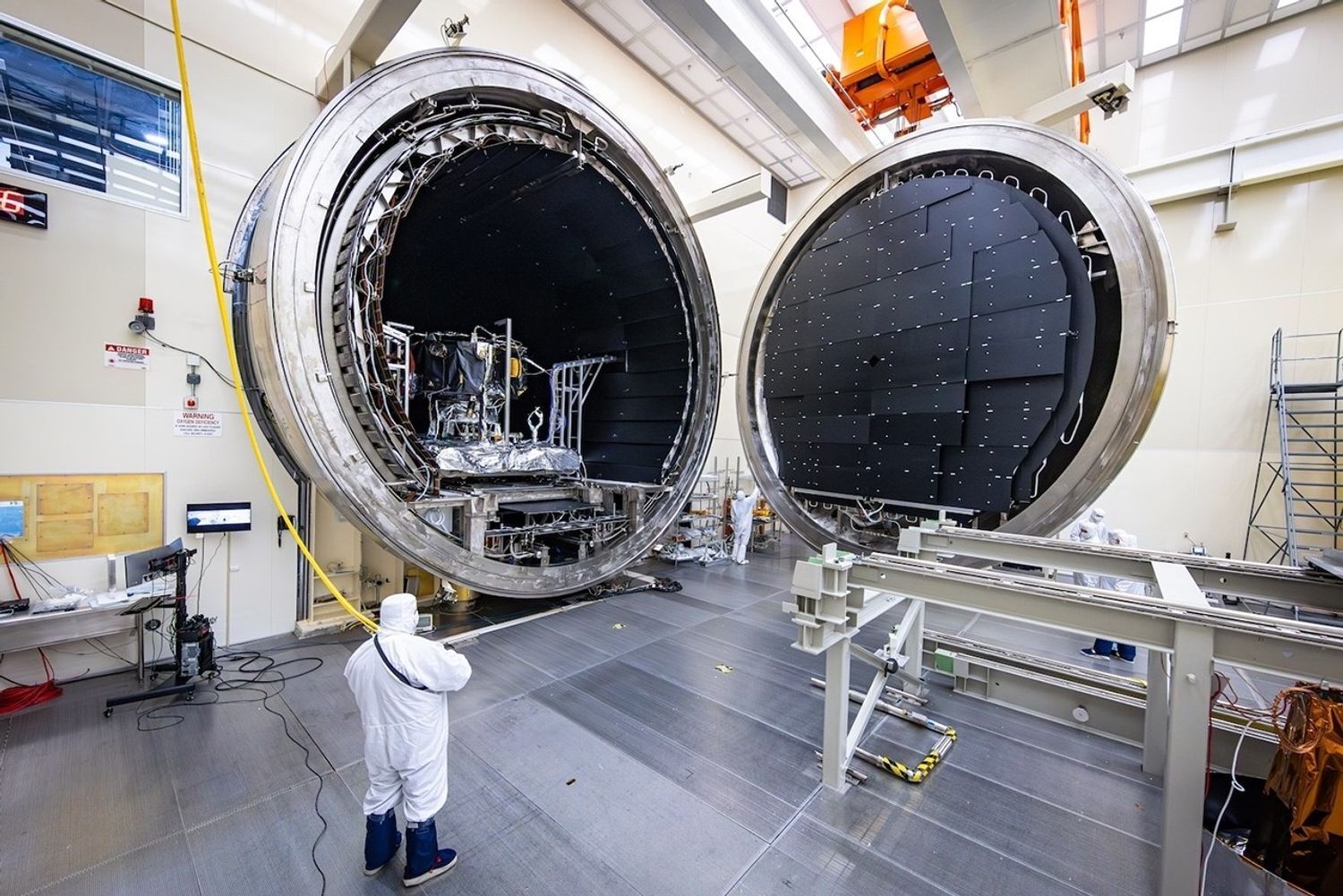
NASA’s IMAP (Interstellar Mapping and Acceleration Probe) spacecraft arrived May 10 for processing at the Astrotech Space Operations Facility near the agency’s Kennedy Space Center in Florida. The mission will study how the Sun shapes the boundaries of the heliosphere, the bubble around our solar system.
A semitrailer transported the spacecraft from NASA’s Marshall Space Flight Center in Huntsville, Alabama, after completing thermal vacuum testing, which simulates the harsh conditions of space, at the X-ray and Cryogenic Facility. Astrotech provides the facility and technicians to prepare the spacecraft for launch, including fueling and encapsulation.
NASA’s IMAP will use 10 science instruments to study and map the heliosphere, a vast magnetic bubble surrounding the Sun protecting our solar system. The spacecraft will orbit the Sun near Lagrange Point 1, about one million miles from Earth to scan the heliosphere, analyze the composition of charged particles, and investigate how those particles move through the solar system. The IMAP spacecraft also will continuously monitor solar wind and cosmic radiation. This information can provide early warnings about space weather, which can affect human space explorers and technological systems like satellites and power grids that can affect life on Earth.
The IMAP spacecraft will launch no earlier than fall 2025 on a SpaceX Falcon 9 rocket from Launch Complex 39A at NASA Kennedy.
Princeton University professor David J. McComas leads the IMAP mission with an international team of 25 partner institutions. The Johns Hopkins Applied Physics Laboratory in Laurel, Maryland, builds the spacecraft and operates the mission. NASA’s IMAP is the fifth mission in NASA’s Solar Terrestrial Probes program portfolio. The Explorers and Heliophysics Project Division at NASA’s Goddard Space Flight Center in Greenbelt, Maryland, manages the program for the agency’s Heliophysics Division of NASA’s Science Mission Directorate.
NASA Moves Heliosphere Mapping Spacecraft for Fueling

Technicians continue preparing NASA’s IMAP (Interstellar Mapping and Acceleration Probe) mission for its upcoming launch. The team moved the observatory to the clean room where they loaded propellant into the spacecraft at the Astrotech Space Operations Facility near NASA’s Kennedy Space Center in Florida.
Technicians loaded more than 317 pounds (or 144 kilograms) of hydrazine into three tanks on the observatory on Aug. 18. The IMAP spacecraft’s propulsion system enables the attitude control system to repoint the spacecraft, adjust its spin rate, correct its trajectory, insert it into orbit at Lagrange point 1 – which is about a million miles from Earth toward the Sun – and perform corrective maneuvers as needed to maintain its position throughout its mission.
NASA’s IMAP will explore and map the boundaries of the heliosphere — a huge bubble created by the Sun’s wind that encapsulates our entire solar system — and study how the heliosphere interacts with the local galactic neighborhood beyond. The IMAP mission will also advance our understanding of how solar particles are accelerated to high energies. Additionally, IMAP can supply to scientists near real-time observations of the solar wind and energetic particles, which can produce hazardous conditions in the space environment near Earth.
Recently, technicians tested IMAP’s 10 science instruments. All have been packaged and stowed in preparation for launch.
In addition to IMAP, workers also have loaded propellant into the observatory’s two rideshares, NASA’s Carruthers Geocorona Observatory and National Oceanic and Atmospheric Administration’s (NOAA) Space Weather Follow On L1 satellite.
All three spacecraft will launch on a SpaceX Falcon 9 rocket no earlier than September from Launch Complex 39A at NASA Kennedy.

NASA's next big mission prepares for launch in Titusville. Meet IMAP spacecraft.
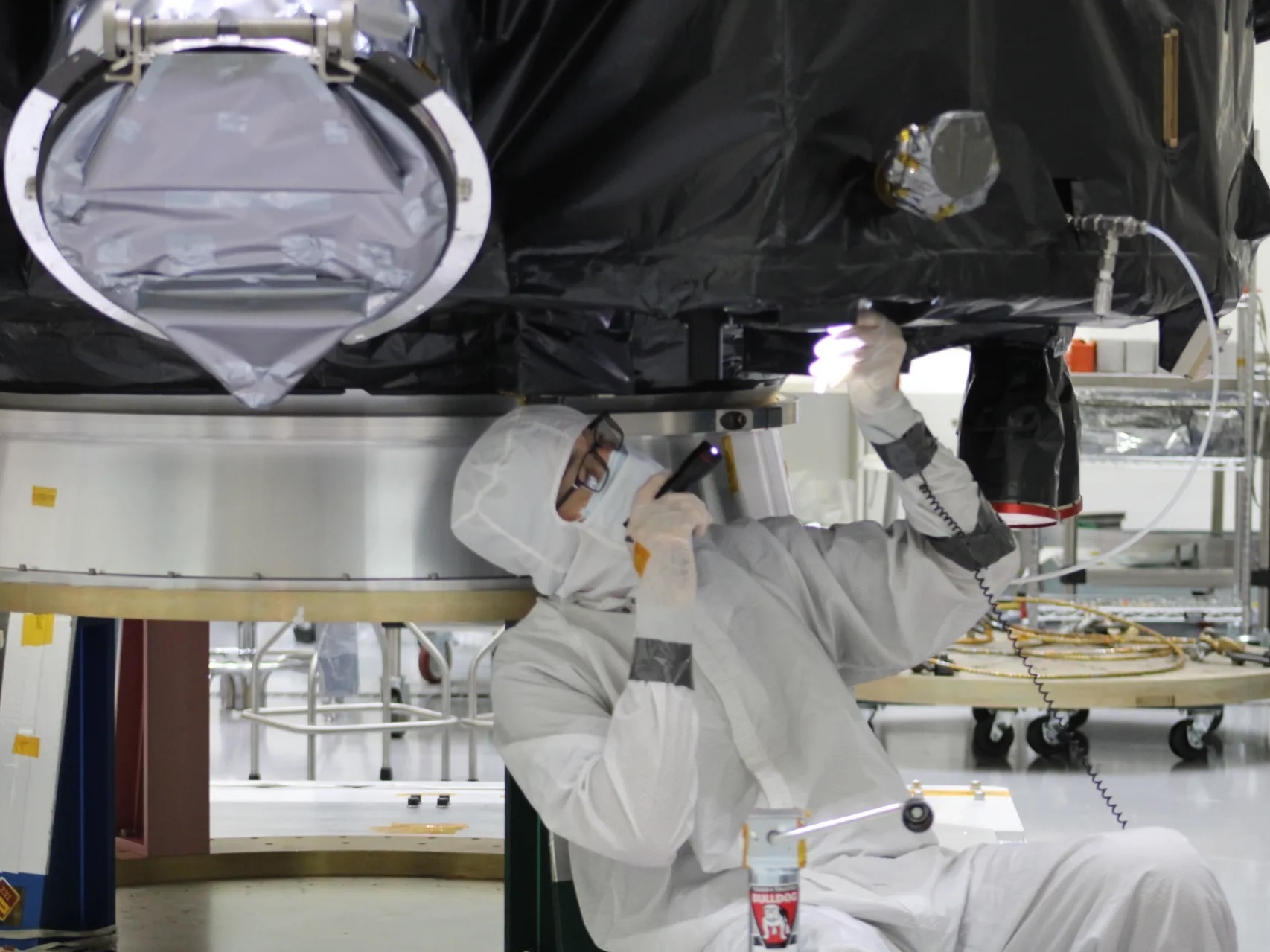
In Astrotech's Titusville facility, the NASA IMAP mission is prepped alongside the Carruthers Geocorona Observatory and NOAA SWFO-L1 mission.
- NASA's IMAP mission, launching in late September from KSC, will study solar wind and its impact on Earth.
- IMAP will travel to Lagrange Point 1, a million miles from Earth, to collect data and provide up to 30 minutes of warning before harmful solar radiation reaches Earth.
- Two other spacecraft, NOAA's SWFO-L1 and NASA's Carruthers Geocorona Observatory, will launch alongside IMAP.
NASA's next big science mission is being prepared in Titusville ahead of a late September launch. The goal: better understand our Sun and provide timely warning ahead of space weather events.
Meet IMAP.
Set to launch atop a SpaceX Falcon 9 rocket no earlier than late September from NASA's Kennedy Space Center Pad 39A, the spacecraft will study the Sun's activities. IMAP arrived in May at the Astrotech facility in Titusville, and has been undergoing testing and processing. Now the spacecraft is fueled and going through the final steps before integration into a SpaceX payload fairing.
In mid-September, the spacecraft will be headed to meet its Falcon 9 rocket — and finally onto the launch pad a few days before liftoff.
"IMAP is planning to study solar wind as well as energetic ions that are being released out into the heliosphere from the Sun," IMAP program manager Kieran Hegarty told FLORIDA TODAY. Simply put, the mission is looking at solar wind — or space weather — which can have an impact on Earth.
It is also looking into the extent of the heliosphere. Formed by solar wind, the heliosphere is a vast bubble which surrounds our solar system.
IMAP will collect its data using 10 sophisticated onboard instruments, which are a collaboration of an international team of 25 partners. The spacecraft itself is divided into six bays, which hold 12 instrument sensors. There's also one large sensor on the top of the craft.
IMAP may not look large at only 3ft tall and 8 ft in diameter but it weighs 1,984 lbs. Media got a first-hand look at the spacecraft inside the Astrotech facility in Titusville, Florida as it's being prepared for launch.
The spacecraft is set to travel 108 days to the Earth-Sun Lagrange Point 1 (L1), an area 1 million miles from Earth in which the spacecraft can orbit the Sun alongside the Earth.
The data collected will assist with space weather predictions. That's important because solar activity can harm satellites in orbit as well as astronauts and space technology. IMAP will be able to provide up to 30 minutes of warning before harmful solar radiation arrives at Earth. This will allow for more advanced warning than ever before.
But IMAP is not traveling alone to L1. Along for the ride are the National Oceanic and Atmospheric Administration (NOAA) SWFO-L1 and the NASA Carruthers Geocorona Observatory spacecrafts.
In a nearby clean room at Astrotech, these two other missions were being prepared for launch day.
The Carruthers Geocorona Observatory will map the Earth's exosphere, or highest layer. It will do so by looking at ultraviolet light emitted from Earth's upper atmosphere, which is referred to as Earth's "geocorona." During a study by Dr. George Carruthers conducted on the Apollo 16 mission, it was discovered that Earth's exosphere extends as far as the moon. But just how far remains a mystery.
Meanwhile, the National Oceanic and Atmospheric Administration(NOAA) SWFO-L1 will observe space weather − or charged particles from the Sun.
"Astrotech is integral in the upcoming rollout and eagerly awaits this important launch, making this our 551st Spacecraft processed to date," Robert Curbeam, CEO and president of Astrotech Space Operations was quoted as saying in an Aug. 28 press release.
Next up: these spacecraft will be headed for NASA's Kennedy Space Center Pad 39A. Then those on the Space Coast can look forward to the late September liftoff of these three Sun-centric missions.
Quelle: Florida Today
----
Update: 17.09.2025
.
NASA Sets Launch Coverage for Space Weather Missions
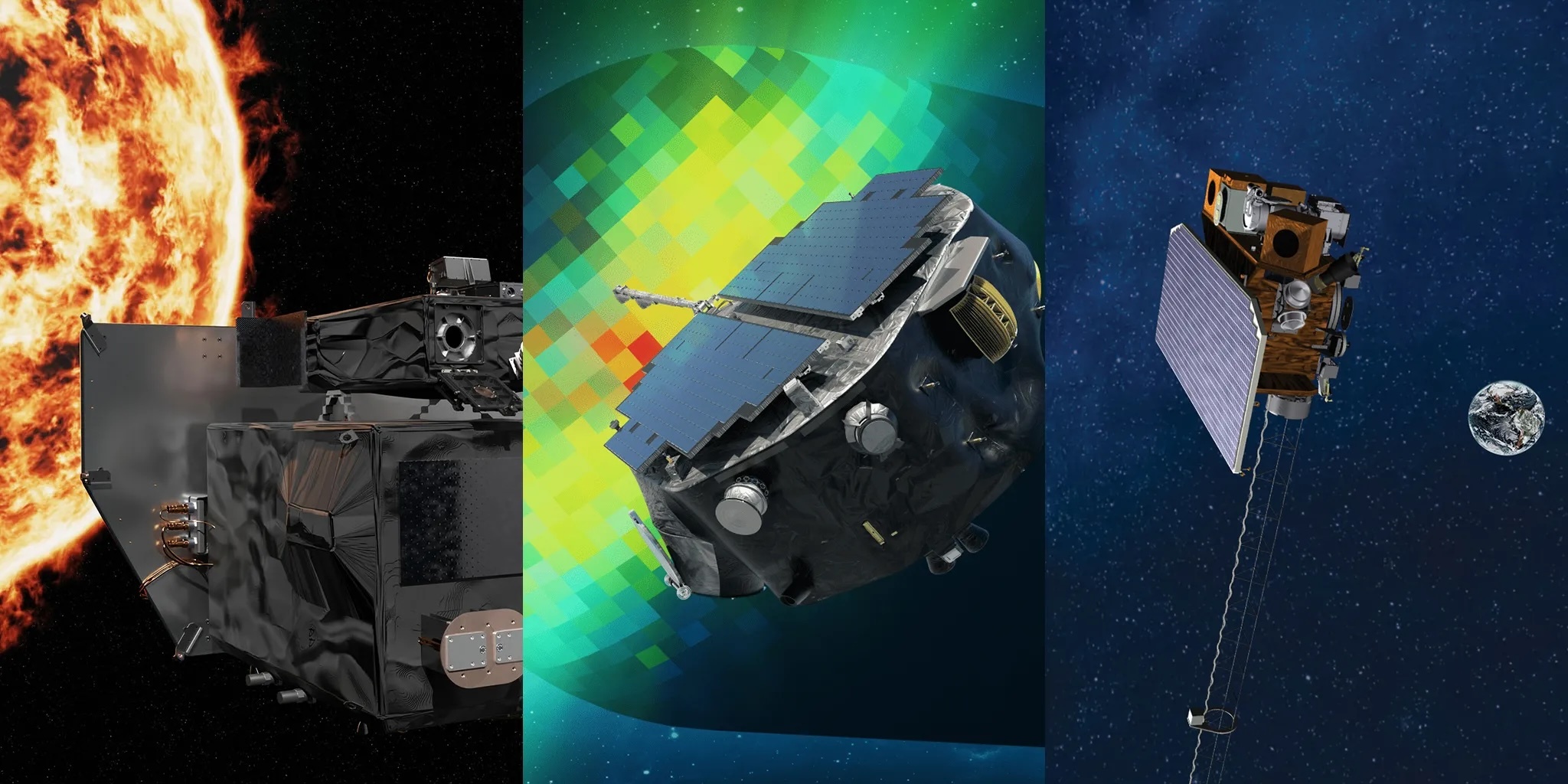
NASA will provide live coverage of prelaunch and launch activities for an observatory designed to study space weather and explore and map the boundaries of our solar neighborhood.
Launching with IMAP (Interstellar Mapping and Acceleration Probe) are two rideshare missions, NASA’s Carruthers Geocorona Observatory and the National Oceanic and Atmospheric Administration’s (NOAA) Space Weather Follow On-Lagrange 1 (SWFO-L1), both of which will provide insight into space weather and its impacts at Earth and across the solar system.
Liftoff of the missions on a SpaceX Falcon 9 rocket is targeted for 7:32 a.m. EDT, Tuesday, Sept. 23, from Launch Complex 39A at NASA’s Kennedy Space Center in Florida. Watch coverage beginning at 6:40 a.m. on NASA+, Amazon Prime, and more. Learn how to watch NASA contentthrough a variety of platforms, including social media.
The IMAP spacecraft will study how the Sun’s energy and particles interact with the heliosphere — an enormous protective bubble of space around our solar system — to enhance our understanding of space weather, cosmic radiation, and their impacts on Earth and human and robotic space explorers. The spacecraft and its two rideshares will orbit approximately one million miles from Earth, positioned toward the Sun at a location known as Lagrange Point 1.
NASA’s Carruthers Geocorona Observatory is a small satellite that will observe Earth’s outermost atmospheric layer, the exosphere. It will image the faint glow of ultraviolet light from this region, called the geocorona, to better understand how space weather impacts our planet. The Carruthers mission continues the legacy of the Apollo era, expanding on measurements first taken during Apollo 16.
The SWFO-L1 spacecraft will monitor space weather and detect solar storms in advance, serving as an early warning beacon for potentially disruptive space weather, helping safeguard Earth’s critical infrastructure and technological-dependent industries. The SWFO-L1 spacecraft is the first NOAA observatory designed specifically for and fully dedicated to continuous, operational space weather observations.
Media accreditation for in-person coverage of this launch has passed. NASA’s media credentialing policy is available online. For questions about media accreditation, please email: ksc-media-accreditat@mail.nasa.gov.
NASA’s mission coverage is as follows (all times Eastern and subject to change based on real-time operations):
Sunday, Sept. 21
2:30 p.m. – NASA Prelaunch News Conference on New Space Weather Missions
- Nicky Fox, associate administrator, Science Mission Directorate, NASA Headquarters in Washington
- Brad Williams, IMAP program executive, NASA Headquarters
- Irene Parker, deputy assistant administrator for Systems at NOAA’s National Environmental Satellite, Data, and Information Service
- Denton Gibson, launch director, NASA’s Launch Services Program, NASA Kennedy
- Julianna Scheiman, director, NASA Science Missions, SpaceX
- Arlena Moses, launch weather officer, 45th Weather Squadron, U.S. Space Force
Watch the briefing on the agency’s website or NASA’s YouTube channel.
Media may ask questions in person or via phone. Limited auditorium space will be available for in-person participation for previously credentialed media. For the dial-in number and passcode, media should contact the NASA Kennedy newsroom no later than one hour before the start of the event at ksc-newsroom@mail.nasa.gov.
3:45 p.m. – NASA, NOAA Science News Conference on New Space Weather Missions
- Joe Westlake, director, Heliophysics Division, NASA Headquarters
- David McComas, IMAP principal investigator, Princeton University
- Lara Waldrop, Carruthers Geocorona Observatory principal investigator, University of Illinois Urbana-Champaign
- Jamie Favors, director, Space Weather Program, Heliophysics Division, NASA Headquarters
- Clinton Wallace, director, NOAA Space Weather Prediction Center
- James Spann, senior scientist, NOAA Office of Space Weather Observations
Watch the briefing on the agency’s website or NASA’s YouTube channel.
Media may ask questions in person and via phone. Limited auditorium space will be available for in-person participation. For the dial-in number and passcode, media should contact the NASA Kennedy newsroom no later than one hour before the start of the event at ksc-newsroom@mail.nasa.gov. Members of the public may ask questions on social media using the hashtag #AskNASA.
Monday, Sept. 22
11:30 a.m. – In-person media one-on-one interviews with the following:
- Nicky Fox, associate administrator, Science Mission Directorate, NASA Headquarters
- Kieran Hegarty, IMAP project manager, Johns Hopkins University Applied Physics Lab
- Jamie Rankin, IMAP instrument lead for Solar Wind and Pickup Ion, Princeton University
- John Clarke, Carruthers deputy principal investigator, Boston University
- Dimitrios Vassiliadis, SWFO-L1 program scientist, NOAA
- Brent Gordon, deputy director, NOAA Space Weather Prediction Center
Remote media may request a one-on-one video interview online by 3 p.m. on Thursday, Sept. 18.
Tuesday, Sept. 23
6:40 a.m. – Launch coverage begins on NASA+, Amazon Prime and more. NASA’s Spanish launch coverage begins on NASA+, and the agency’s Spanish-language YouTube channel.
7:32 a.m. – Launch
Audio-Only Coverage
Audio-only of the launch coverage will be carried on the NASA “V” circuits, which may be accessed by dialing 321-867-1220, or -1240. On launch day, “mission audio,” countdown activities without NASA+ media launch commentary, will be carried on 321-867-7135.
Quelle: NASA
----
Update: 23.09.2025
.
NASA’s IMAP Mission ‘Go’ for Launch
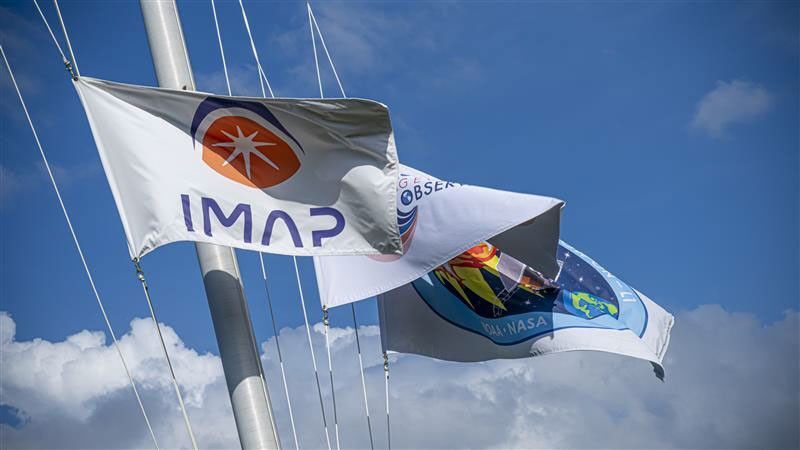
NASA, SpaceX, and spacecraft mission managers are moving forward with the launch of the agency’s IMAP (Interstellar Mapping and Acceleration Probe) mission to study space weather from the Sun and map the edges of our solar system.
During the agency’s Launch Readiness Review, Dr. Denton Gibson, NASA’s launch director, and the launch team polled “go” for launch for IMAP and its two rideshares: NASA’s Carruthers Geocorona Observatory and the National Oceanic and Atmospheric Administration’s (NOAA) Space Weather Follow On – Lagrange 1 (SWFO-L1) satellite.
NASA will host a prelaunch news conference at 2:30 p.m. EDT Sunday to discuss the three missions. Coverage will stream on the agency’s website and YouTube channel with the following participants:
- Dr. Nicky Fox, associate administrator, Science Mission Directorate, NASA Headquarters
- Brad Williams, IMAP program executive, NASA Headquarters
- Irene Parker, deputy assistant administrator for Systems at NOAA’s National Environmental Satellite, Data, and Information Service
- Dr. Denton Gibson, launch director, NASA’s Launch Services Program, NASA Kennedy
- Julianna Scheiman, director, NASA Science Missions, SpaceX
- Arlena Moses, launch weather officer, 45th Weather Squadron, U.S. Space Force
Following the news conference, the agency will host a science overview news conference at 3:45 p.m., also streaming on the agency’s website and YouTube channel with the following participants:
- Dr. Joe Westlake, director, Heliophysics Division, NASA Headquarters
- Dr. David J. McComas, IMAP principal investigator, Princeton University
- Dr. Lara Waldrop, Carruthers Geocorona Observatory principal investigator, University of Illinois Urbana-Champaign
- Jamie Favors, director, Space Weather Program, Heliophysics Division, NASA Headquarters
- Clinton Wallace, director, NOAA Space Weather Prediction Center,
- Dr. James Spann, senior scientist, NOAA Office of Space Weather Observations
Liftoff of the IMAP mission is targeted for 7:32 a.m. on Tuesday, Sept. 23, aboard a SpaceX Falcon 9 rocket at Launch Complex 39A from NASA’s Kennedy Space Center in Florida. If needed, a backup opportunity is available at 7:30 a.m. on Wednesday, Sept. 24.
Quelle: NASA
